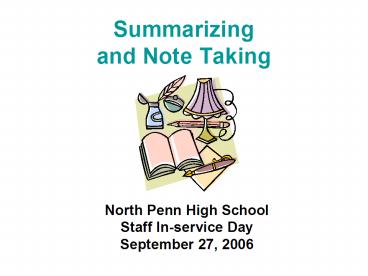Summarizing and Note Taking - PowerPoint PPT Presentation
1 / 25
Title:
Summarizing and Note Taking
Description:
Replace quiz grade with journal grade. Assess using Bloom's Taxonomy. ... Uses the relative size of connected circles to indicate the relationship between ideas. ... – PowerPoint PPT presentation
Number of Views:1141
Avg rating:3.0/5.0
Title: Summarizing and Note Taking
1
Summarizing and Note Taking
- North Penn High School
- Staff In-service Day
- September 27, 2006
2
Summarizing and Note Taking
- Students who can effectively summarize learn to
synthesize information, a higher-order thinking
skill which includes analyzing information,
identifying key concepts, and defining extraneous
information. - Northwest Regional Education Laboratory
3
Classroom Instruction That Works
4
Summarizing Strategies
5
SummarizingSteps for Rule-Based Summarizing
- Delete trivial material that is unnecessary to
understanding. - Delete redundant material.
- Substitute super-ordinate terms for more specific
terms.(ie. fish for trout, salmon, flounder) - Select a topic sentence or invent one if it is
missing.(Brown, Campione, and Day, 1981)
http//dese.mo.gov/divimprove/curriculum/ModelCurr
iculum/current_events/lesson_six.htm
http//genesismission.jpl.nasa.gov/educate/scimodu
le/data/briefing/SARule_Based.pdfsearch22rule2
0based20summarizing22
6
Summary Frames
- Summary Frames are a series of questions that a
teacher provides to students. The questions are
based on the type of passage being studied.
7
Summary Frames
- Narrative Frame
- Definition Frame
- Argumentation Frame
- Problem-Solution Frame
- Conversation Frame
- Topic-Restriction-Illustration Frame
http//www.d214.org/staff/depts/staffsupport/Schoo
lImprovement/GraphicOrganizer/
8
Reciprocal TeachingGroup-Enhanced Summary
- Summarizing
- Questioning
- Clarifying
- Predicting
http//literacy.kent.edu/eureka/strategies/summari
zing.pdfsearch22rule20based20summarizing22
9
How to Summarize an Article
- Why the article was written and who is the
intended audience? - What is the authors background? Point of view?
- Compare opening and closing statements.
- Read the article more than once.
- Underline key words and phrases.
- Distinguish main ideas from supporting ideas.
- From University of Texas at Austin Learning
Center
10
Note Taking Strategies
11
Note Taking
- Verbatim note taking is the least effective way
to take notes - Notes should be considered a work in progress
- Notes should be used as a study guide for tests
- The more notes that are taken, the better
12
Dialectical Journal Writing
- Is a double-entry journal.
- Is completed during the reading process.
- Forces students to slow down the reading process,
think about the content of the assignment,
process their thoughts about the reading, and
keep a record of their thoughts.
http//www.phschool.com/eteach/social_studies/2001
_02/essay.html
13
Dialectical Journal 1
- Copy of the Text
- Student writes down significant quotes from the
text. - Student must include page number.
- If appropriate, student could also include
authors name, chapter number, etc.
- Students Reactions and Analysis to the Text
- Student writes reaction and analysis to the
significant quote he or she has chosen. - Analysis should be longer than the quote.
14
Dialectical Journal 2
- Paraphrase of Text
- Student writes a paraphrase or a summary of the
text. - Student records page number.
- If appropriate, student records authors names,
title, chapter, etc.
- Significance and Analysis of Text
- Student records analysis and evaluation of the
content information provided in the text. - Student makes connections between the information
presented.
15
Dialectical Journal 3
- The Authors Opinion
- The Students Opinion
16
Dialectical Journal 4
Write a statement, summary, or quote at the top
of the page.
- Student 1 responds to the quote and analyzes the
quote.
- Student 2 responds to Student 1s statement.
NOTE Keep passing paper around.
17
Dialectical Journal 5
- Left Page
- Copy of the text students are reading
- Right Page Split into two columns
Students reaction and analysis after class
discussion.
Students initial reaction and analysis to the
text.
Source Lucy Calkins Double-Entry Ledger
18
University of WashingtonDialectical Journal
- Record Column
- Date
- Name of the author
- Pages Read
- Main subject
- Summary of Main Points
- React Column
- Write your position statement on the subject
- Compare your position statement with the one in
your source - Explain the focus on this reading, lecture,
program, etc. - Relate the material to the course
19
Possible Evaluations of Dialectical Journals
- Assess on an all or nothing basis.
- Required number of quotes or lines.
- Assess randomly during the marking period.
- Replace quiz grade with journal grade.
- Assess using Blooms Taxonomy.
- Provide Blooms Taxonomy and have students
self-assess their journals.
http//edtech.clas.pdx.edu/presentations/frr99/blo
oms.htm
http//www.dickinsonstate.com/pdf/WRTC/Bloom's
verbs.pdf - search"blooms verbs"
20
Note TakingVocabulary Quadrant Cards
Paraphrase of definition
definition
word or term
picture/ symbol or sentence using word or term
synonyms and antonyms
21
Informal Outline Notes
- Common note taking practice
- Uses indentations to indicate major ideas and
their related details
http//www.lib.jjay.cuny.edu/research/outlining.ht
ml
22
Webbing
- Uses the relative size of connected circles to
indicate the relationship between ideas. - Lines are drawn from one circle to another to
show the relationship between the concepts.
http//www.sdcoe.k12.ca.us/SCORE/actbank/torganiz.
htm
23
Combination Notes
- Flexible note taking strategy
- Combines the informal outline with pictures or
graphic representations - Often used in a two-column or double-entry style
format
24
Note Making Tools
- Bookmarks
- Continuum
- Conversational Roundtable
- Cornell Notes
- Episodic Notes
- Hierarchical Notes
- Inference Notes
- Lit Circle Notes
- Judges Notes
- Q Notes
- Sensory Notes
- Spreadsheet Notes
- T-chart Notes
- Think in Threes Notes
- From The English Companion
http//web000.greece.k12.ny.us/instruction/ela/6-1
2/Tools/Index.htm
http//www.englishcompanion.com/Tools/notemaking.h
tml
25
Summarizing and Note TakingTechnology Application
- MS Word Track Changes
- Power Point Slides and Outlines
- Inspiration Mind Maps, Clusters, Outlining
- Excel Grades, Effort Log
- From Instructional Services, 2006






























